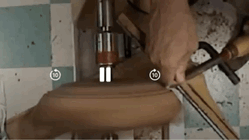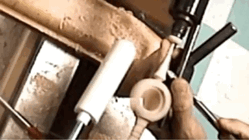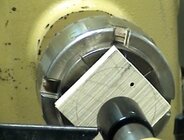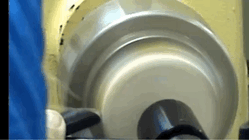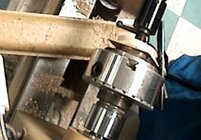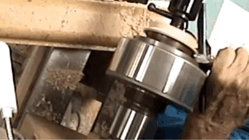Some of us beginners learn from YouTUBE, but we see pros do things that are seemingly unsafe. I see it as a real issue until you develop some sense of what is prudent. This is just a few things I’ve seen that seem like big NOs for me. Am I being overly paranoid?
1. Starting a bowl blank on a wood worm screw with lathe turning and holding the blank by hand
2. Turning with fingers hanging over the tool rest. A perfect setup to crush a finger between tool rest and wood.
3. Similarly, sanding using the tool rest to brace hand.
4. Taking a huge cut with a bowl gouge on an a rough bowl blank with no tailstock support with a relatively small tenon in the chuck.
5. Turning with no face shield or even safety glasses in sight.
I could go on and on, but are these folks just lucky or does their experience change the relative danger of this kind of stuff? and beginners trying to imitate without thinking through it.
Not a pro, but I do try to be safe.
1. Only at a very low RPM, but it does make it easier to put pressure on the blank from the bottom so it threads on properly. I would not do this at a high RPM.
2. NEVER. EVER. Now, finger swung underneath, so that its not resting on the toolrest, sometimes, to help stabilize the blank or something like that. But only when the blank is smooth and round.
3. Never tried this... I usually remove the tool rest entirely when I sand (and I always sand by hand), so its never there as a temptation even.
4. If you have sufficiently sharp tools, and are not cutting past the end of the wing, meaning you have a full, sharp edge in the wood, and you are using the bevel properly (so you can't catch), then a small tenon will work as long as it is secure. The key, is tool sharpness. When you use very very sharp tools, the amount of force involved when taking a cut, even a large one, is relatively small...because the edge is cutting and removing wood. If you feel there is too much force involved, then your edge has dulled...so go resharpen. This also may depend on the type of wood, and whether it is green or dry. With green wood, you can often take huge cuts without much issue, especially on softer woods. On harder woods, and with dry woods, you might not be able to take a full elseworth gouge from tip to the back of the wing....unless it is just exceptionally sharp, but if you feel like its going to rip the bowl out of the blank, then take a smaller cut. In any case...I think this is more to do with tool sharpness. A very sharp tool will move through the wood like butter, and so long as you are properly using the bevel to support the tool, then you will cut and not catch or grab.
5. I use a face shield. I am a bit paranoid about this. I have worn glasses most of my life, and my most recent few pairs have been extremely expensive (IIRC, the last pair of glasses, which correct my vision pretty much perfectly, and give me extremely clear vision, was $1200), and I am always afraid of damaging them. I have had some bowls blow up on me in the past as well, and if it hadn't been for the face shield, sometimes these pieces can go flying at pretty high speed. I tried my hand at inside-out Christmas ornaments a couple of years ago, and I had a number of those fly apart as well (poor quality double sided tape!) I have also had issues with finish or more specifically CA glue, flying off the lathe, if I turn it on before its entirely cured. I actually have a small dot of CA glue on my glasses right now...thankfully its near the top rim, and is not in the center of my vision, but I've had that in the past as well. A face shield will keep finish or CA spatter off your face. So its safe and otherwise convenient for other reasons.
Something else that should also be noted, is a respirator of some kind. Boy, the amount of times I see turners in their videos not wearing even a simple unported N95 mask, let alone a respirator, to do even a minimal job of keeping wood dust out of their lungs and nasal passages... I recently heard a story of a guy who had to stop turning entirely, because he can't breath through his nose, and when they really went looking for a reason why, they found none other than an insane amount of wood dust packed into his nasal passages and sinuses! I guess he is going to have to have surgery to clear things out, and its not a trivial surgery, since they have to get into the various sinus passages? That story kind of terrified me. I hear something similar can happen to your lungs as well. Wood dust doesn't just get broken down in your body...if it gets in there, it accumulates, and builds up...

Another thing I always do, is use push sticks or something like that, when cutting things on a table saw. Or a sled. I try to always use a sled for my bandsaw, except when I'm rounding out small branches/logs when trimming off the nubs of branches and the like. I never drill with the drill press, unless whatever I am drilling is securely clamped down (well, very early on, I had a piece I was just hand holding ride right up the drill bit, in less than a second! Scared me as my hand went strait up too, but thankfully not into the bit. Ever since then, I clamp whatever I drill.)
I use at least safety glasses with the table saw, but sometimes I'll use a face shield. I try to avoid kickback as much as I can, and use the safety features of my table saw (except when using the sled, since those features are just not an option when using a sled) to try and limit how much kickback can even occur. Still, I've seen enough cases where people just, make a tiny mistake, and non-trivial sized pieces of wood can roll right up on top of the blade an go flying right back at the operator, at high speed!
I heard a saying years ago: "Safety is first and foremost a choice." It really is!

